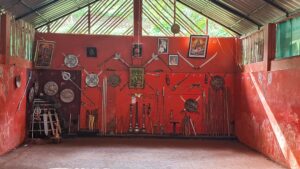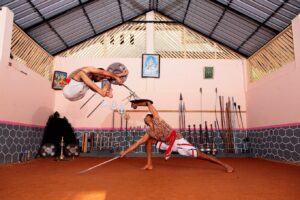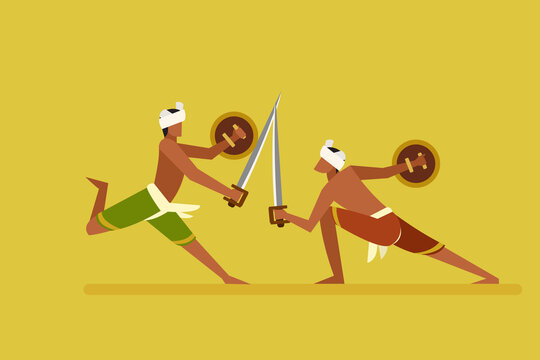Kerala’s Kalaripayattu – one of the world’s oldest martial arts carries a legacy of over 3000 years. A rare combination of relaxation, yoga, meditation and self-defense, this martial art form has withstood vagaries of time and changes. The Ministry of Youth Affairs and Sports, Government of India recognized Indian Kalaripayattu Federation as a regional sports federation giving the art form its much needed recognition.
Its Origin and Evolution
Kalaripayattu, the ancient Indian art form, traces its origin to Kerala. The word Kalaripayattu originates from two different Malayalam words- Kalari, which means battleground, and payattu, which means training of martial arts.
Sage Parasurama, the sixth incarnation of Lord Vishnu, is believed to have learned this art from Lord Shiva and taught it to the original settlers of Kerala shortly after reclaiming Kerala from the sea. It was during the medieval period that this art form got prominence when warriors and soldiers practiced kalaripayattu for physical and spiritual preparation.
A Holistic Approach
Kalaripayattu incorporates elements of traditional Indian spirituality. Practitioners pay homage to Hindu deities before training or performances, some may seek blessings or protection from deities before engaging in Kalaripayattu, considering it a form of divine intervention that enhances their protection and safeguards them from harm. The art form has historical and cultural ties to spirituality and mythology that make the connection to divinity relevant and meaningful for many practitioners.
A Living Example: Sree Rudra C.V.N. Kalari

Sree Rudra C.V.N Kalari, Lakattoor, in Kottayam district of Kerala, is a renowned group for Kalaripayattu and Kalari Massage. It was founded by Ajithkumar Gurukkal in 1996, and this Kalari specializes in the “Kuzhi Kalari style,” with a particular emphasis on Meypayattu, a fundamental aspect of the northern style.

The center has played an important role in training an estimated 5,000 Kalaripayattu enthusiasts over the years. People from Japan, Switzerland, and France have also visited this place seeking short-term courses. Ajithkumar Gurukkal who is the founder of this Kalari centre travels extensively across India promoting Kalaripayattu. He promotes various advantages served by Kalaripayattu and Kalari Massages.
‘’Kalaripayattu is not just a fight; it will help an individual to transform physically and mentally. Once many foreigners came to Kerala for Kalaripayattu training. Now this rich art form is in a state of vanishing, so necessary steps should be taken for the preservation and promotion of Kalaripayattu, says a master from Sree Rudra Kalari.
He adds that the training includes body conditioning, weapon training, empty-hand techniques, meditation and yoga, and lastly healing practices. Also, Kalaripayattu has different styles, or Vazhi, with different purposes. Based on the regions they are practiced in, the two popular styles are the Northern style, or Vadakkan Kalari, and the Southern style, or Thekkan Kalari.
Northern Kalaripayattu is based on sophisticated and stretchy movements, evasions, jumps, and weapons training, while the southern form of Kalaripayattu is forceful, impact-based techniques with priority on hand-to-hand combat and pressure point strikes.
Why It Matters Today
The revival of Kalaripayattu is very significant in this globalization age, where local culture and customs seem to be at risk. Kalaripayattu is a reminder of Kerala’s rich culture and heritage. Additionally, this art form helps for the well-being of mind and body and rejuvenate one’s lifestyle. Also, Kalaripayattu has a big scope when it is incorporated with tourism, and thus it will attain global recognition.
More than just a martial art, Kalaripayattu helps to inspire and flourish many generations of its artistic beauty and historical relevance. Let’s make this a wake-up call to promote our own culture.
Copyeditor: Aakriti Dubey

